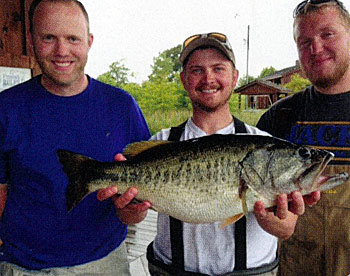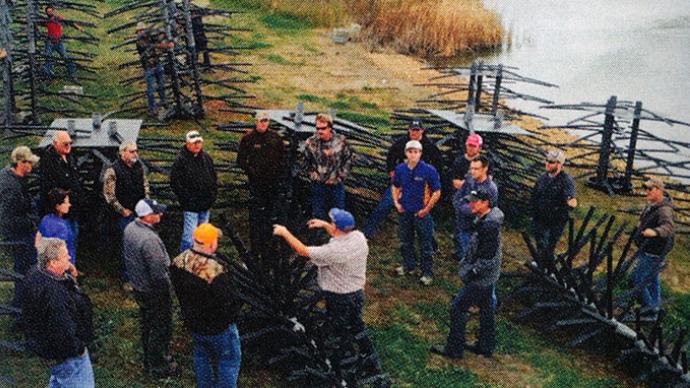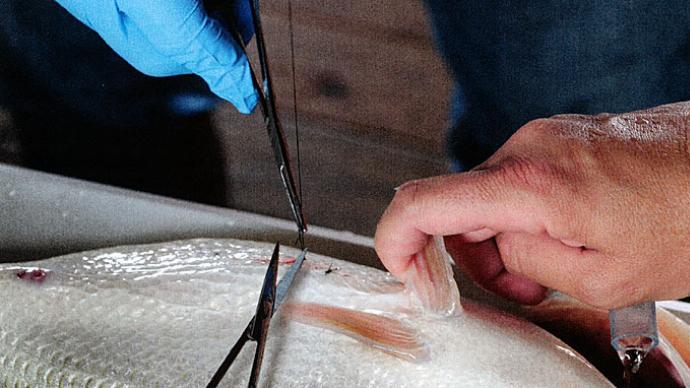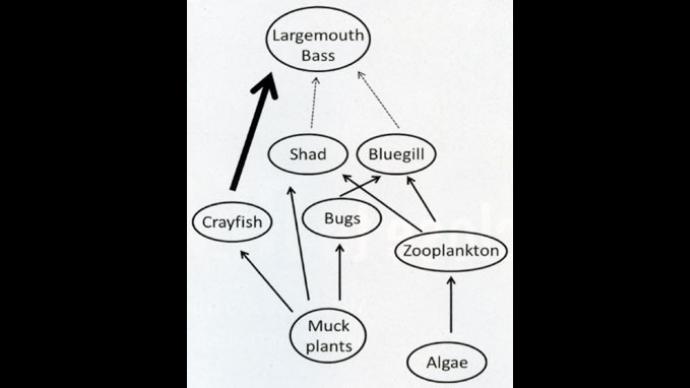
In previous articles, Dr. Brian Graeb described the importance of habitat science as he explained a couple different hypotheses about how habitat may improve sport fish populations. He also discussed our central research question for restoring aging reservoirs: "How much habitat is needed to increase production of largemouth bass, either in terms of abundance or growth?" The focus of this column is to give an update on our research project and discuss some of the results.
My study is focused on evaluating the response of Largemouth Bass to the artificial habitat treatment described in Brian's second article. For readers who may have missed that article, the treatment included 22 fish cities. Each fish city was made up of a combination of horizontal and vertical structures. Some vertical structures had high density limbs and some had low density limbs. All in all, each city was made up of 16 total structures. Fish cities were then placed in areas with different levels of known Largemouth Bass use. The high use cities were places where we had observed radio tagged Largemouth Bass living previously, and the low use cities were areas where we had not directly observed Largemouth Bass living. So it was a large-scale habitat treatment that increased structure within our 100-acre study lake to about 13 percent of the shoreline area in hopes of providing significant benefits to the Largemouth Bass population.
How are Largemouth Bass responding to habitat enhancement?
Did they like our design of the Fish City?
Largemouth Bass are now commonly observed on or near the new fish city sites. We consistently found about 20% of our radio tagged Largemouth Bass on or near (within 15 feet of) the new artificial structure. Prior to placing habitat in these locations, we only observed radio tagged Largemouth Bass in these areas about 5% of the time. These high use areas were where the 5% of Largemouth Bass locations occurred. Interestingly, Largemouth Bass have increased frequency of occurrence in the high use sites from about 5% to over 20% of the time. Additionally, Largemouth Bass have been found occupying the low use areas where they were not previously observed. Thus, the newly added artificial structure appears to be attracting fish to previously used areas as well as to new areas, potentially increasing the useable space in the lake. Now that we know Largemouth Bass are using the habitat, we can try to understand how the habitat may be benefiting the individuals as well as the population as a whole.
Did habitat increase Largemouth Bass production?
It is too early to observe the effects of habitat on increased recruitment of Largemouth Bass, but we have observed a rapid response in terms of growth and condition. We have a unique method to measure how fish respond to habitat. Because of our extensive pre-treatment research, we have several fish we have tracked for several years, allowing us to compare the growth of individual Largemouth Bass pre-and-post habitat enhancement. So, I will focus on increased production in terms of increased growth and/or condition of Largemouth Bass in the population.
First, the growth of the Largemouth Bass, especially large fish, was very slow before the habitat treatment. Coinciding with the habitat treatment, growth appears to be trending upward. Individuals that had not grown in recent years are growing again. Each line on the graph below shows the observed growth of individual Bass. You can see increases in the slope of the line after the habitat treatment for most individuals.
The condition of these large-sized individuals also appears to be improving. Before the habitat treatment, the average condition of all size classes of Largemouth Bass was consistently around 89. This condition is not bad, but is much lower than what we need to achieve a trophy fishery. After placement of habitat, we saw a new strong dichotomy between the conditions offish at different size classes. The smaller fish (those less than 15 inches) are in poorer condition, and the larger fish (those greater than 15 inches) are in great condition. The condition of large fish is now consistently over a 93, with Largemouth Bass over 20 inches averaging conditions of 101. This is exciting, because our trophy fish are now doing very well, and this shift seems to coincide with placement of new structure in the lake. The pictures below shows a few of these fat and happy large Bass.
What does all this mean? It appears that after one year of data collection, the added artificial structure is helping our lake go in the right direction. Growth and condition are improving compared to the pre-habitat years. We also are getting closer to our goal of a trophy fishery. The abundance of Largemouth Bass over 81bs has increased and we have sampled our first bass over lOlbs during the last year.
So, the next big question is, "How does the added habitat promote the shift in the Largemouth Bass fishery to one of potentially higher production (i.e. increased growth of Largemouth Bass) like we are seeing?" To answer this question, it will be important to understand how Largemouth Bass gain and use energy that can be important to growth. So changes in Largemouth Bass movement and prey consumption patterns may provide important insight into understanding the role structural habitat plays in benefitting Largemouth Bass fisheries, but that is the subject of the next article.
Chance Kirkeeng, author of this story, is an M.S. student, South Dakota State University under the tutelage of Dr. Brian Graeb in the Department of Natural Resources, Wildlife and Fisheries Sciences.
Reprinted with permission from Pond Boss Magazine



